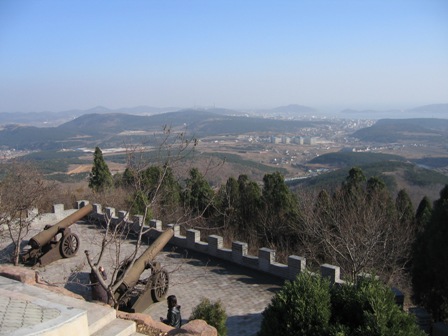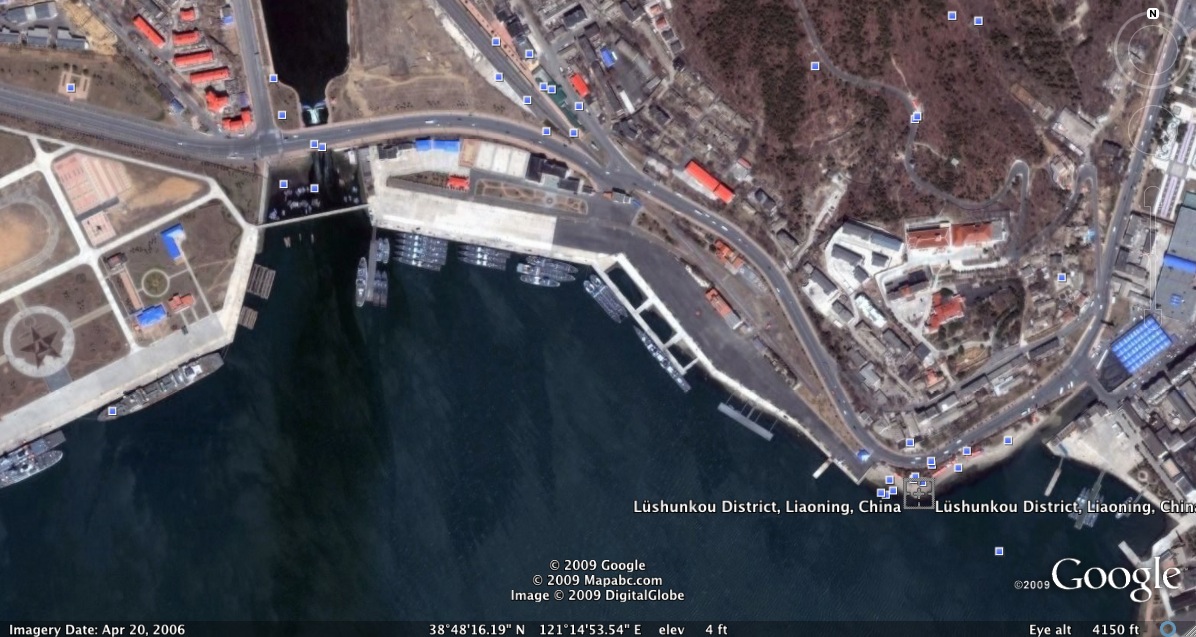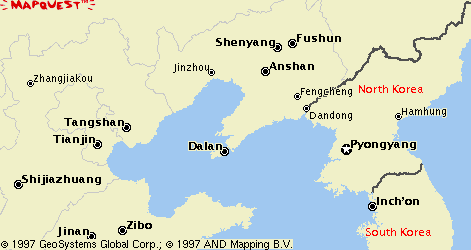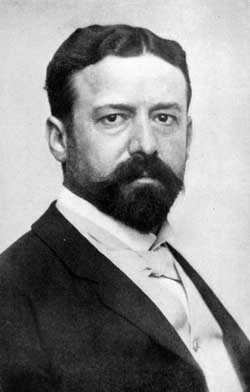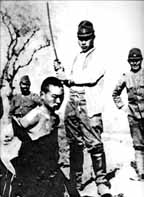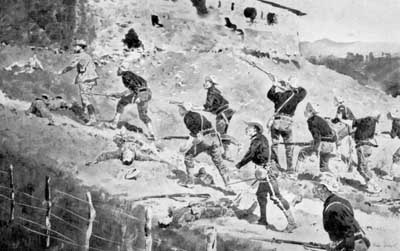Joseph Pulitzer's New
York City flagship
had scored a direct torpedo hit. Yellow
journalism - or what might be called an
early form of human rights reporting - had undermined Japan's claim to
have joined the family of civilized nations.
In a cable to The
World, as
run in that paper December 17, Japan's Foreign Minister Mutsu was
forced to concede that Japan's soldiers "transported with rage at the
mutilation of their comrades by the enemy broke through all
restraints...to inflict vengeance without discrimination."
The apology - and pledge of further investigation - gave further
visibility to James Creelman's December 12 four paragraph page one
report in The World that Japanese soldiers had
entered the Manchurian city of Port Arthur
on November 21 and "massacred practically the entire population in cold
blood." For The World it was an
unprecedented coup to have the Japanese minister cable a confirmation
and apology for events covered by the newspaper - even if Mutsu
protested "against exaggerations calculated to present the affair in a
distorted and misleading aspect" and added "there was absolutely no
intention to harm or molest non-combatants."
Creelman's December 12 dispatch had reported:
"The defenseless and
unarmed
inhabitants were butchered in their houses and their bodies unspeakably
mutilated. There was an unrestrained reign of murder which continued
for three days. The whole town was plundered with appalling atrocities.
It was the first stain upon Japanese civilization. The Japanese in this
instance relapsed into barbarism. All pretenses that circumstances
justified the atrocities are false. The civilized world will be
horrified by the details."
(For Creelman's account of
the massacre in his
memoirs see On
the
Great Highway, Lothrop
Publishing Company, Boston, 1901,
Chapter
5.)
A SIGN OF
THINGS TO COME
The World's
scoop from Port Arthur was a sign of things to come. An American war
correspondent playing international "watchdog" on pony back some 10,000
miles from home had witnessed Japanese excesses. They were to resume on
a far more massive scale during World War II when Japanese forces
massacred or otherwise abused both conquered Asian nationals and
Western prisoners of war. (See activist/author Iris Chang's version).
Only ten years later Japan's military chose Port Arthur as a place to
pioneer the tactic of "surprise
attack," the backbone of Japan's bombing
strike on Pearl
Harbor on December 7, 1941. The Russo-Japanese
War of 1904-5 began on Feb. 8, 1904, when the main Japanese fleet
launched a surprise attack and siege on the Russian naval squadron at
the harbor of Port Arthur.
Creelman's reporting from Port Arthur reflected America's post Civil
War expansion. American journalists joined increasingly outwardly
looking businessmen, missionaries, and military strategists to build
greater United States influence overseas.
Indeed Creelman's later reporting for The World on
Spanish atrocities in Cuba helped crystallize the nationalistic
sentiment which led to victorious war with Spain in 1898 and indirectly
to the take over of Madrid's colonial empire in Cuba and the
Philippines. The U.S. annexed Hawaii in 1898, after landing marines
there in 1893.
This wave of expansion into areas also coveted by Japanese
expansionists made the U.S. a Pacific power. American newspaper
scrutiny of Japanese operations in Manchuria foreshadowed the emergence
of the United States as China's 1930's protector against Japan.
Aggressive American journalism of 1894 thus foreshadowed the
American-Japanese confrontation which brought Japan's effort to remove
American influence in Asia by a surprise attack on the American fleet
in Pearl Harbor.
The World's coverage embarrassed the Japanese
government and provoked a rash of popular nationalistic resentment
against the Western press - especially after Japanese officials were
reported to have accused Creelman and other Western reporters of
supplying allegations of atrocities to Japan's opposition newspapers,
particularly the English language Yokohama Journal.
A SLASH QUICKLY
FORGOTTEN
Creelman's exclusive, as
essentially confirmed by Thomas Cowan of the London Times,
as well as other journalists, and diplomats on the scene, slashed a
hole in Japan's hard won image as a modernizing civilized nation.
It was a slash quickly
forgotten. Admirers of
Japan later concluded Port Arthur was a temporary aberration. Creelman
himself reverted to his positive view of Japanese progress toward
civilization in his 1901 memoirs, On The
Great Highway. In retrospect, he wrote, Japanese conduct
elsewhere in that war and in its 1900 military intervention with
Western allies against the barbarism of China's Boxer
rebellion had set a tone of moderation.
Indeed historians have noted
that to avoid
again alienating Western public opinion, Japan's leaders insured firm
discipline in their armies fighting the Boxers and largely prevented
their soldiers from indulging in the excesses of looting practiced by
many European soldiers. Unlike its Western allies, Tokyo quickly
withdrew its troops after foreigners trapped in Peking were rescued.
Still Creelman's coverage at Port Arthur demonstrated the critical part
journalists can play in the battle over stereotypes. The Creelman scoop
briefly demolished the "good Asian" stereotype Japan had won in the
course of its modernization.
A sensational journalism scoop briefly fueled the "cruel, bad, yellow
Asian stereotype" later revived by Japan's invasion of China and
"sneak" attack on Pearl Harbor.
After World War II Japan was able quickly regain its "good Asian" image
with the democratization and economic "miracle" following American
occupation. In 1950 Chinese Communists
quickly earned the "bad Asian" image as American comic books portrayed
hordes of ant like yellow men in barbaric human wave attacks on
American G.I.'s in Korea.
WAR WITHOUT MERCY
A cycle of World War II atrocities by both Japan and the United States
revived the fearsome , cruel, barbaric Japanese image momentarily
portrayed by Creelman.
American writers, soldiers, filmmakers, and cartoonists portrayed
"Japs" as subhuman animals, inscrutable hordes of unthinking, devious
rats, apes, and vermin to be mercilessly annihilated.
As both sides committed "unspeakable" atrocities, American war
propaganda took on both officially and unofficially a virulent racist
color. Americans tended to see the massive brutality of Japan's
conquering armies, the sword and bayonet executions of civilians and
prisoners of war as evidence of racial inferiority. All across Asia
Japan seemed to repeat the atrocities documented by James Creelman at
Port Arthur in 1894.
Japanese images of Allied opponents as merciless, vicious, racial
inferiors dedicated to repression of Asians were likewise fueled, as
American forces executed Japanese prisoners, cut off ears, extracted
gold teeth, and enthusiastically bombed Japan's civilian population.
The frequent American practice of shooting or knifing those who
surrendered encouraged the Japanese insistence on "fighting to the
death."
John W. Dower's War
Without
Mercy provides an exhaustive
account of how World War II in the Pacific degenerated into a race
fueled battle to the death, with "no quarter" expected nor given.
Germans, argues Dower, were portrayed as "Nazis," so that the
possibility of a "Good German" remained alive. By contrast, Japanese
were virulently labeled in all inclusive racial/ethnic terms as "Japs"
or "Nips" with the often clearly stated implication that "the only good
Jap is a dead Jap."
It is important to remember there was more than a racial divide.
Japanese atrocities in China were widely and vividly publicized BEFORE
Pearl Harbor. The visually compelling footage of Nazi concentration
camps, for the most part, did not come out until the END of World War
II when Allied armies liberated the extermination camps.
CREELMAN'S
BARBARISM IMAGE REVIVED
American newspaper and newsreel coverage of Japanese conquests in China
in the 1930's brought back to life the image of wholesale cruelty
portrayed by Creelman's 1894 coverage at Port Arthur.
A decade of war in China, beginning with the Manchurian
Incident of 1931 and Japan's attack
on
Shanghai in 1932, made it easier for
the American public to see Japan as the stereotypical "bad Asian" --as
opposed to the "good Asian" stereotype held earlier by those who
emphasized Japan's modernization, arts, philosophy, and "civilized"
ways.
In this period Japn's ultra-nationalistic military gradually took
control, partly by assassinating civilian leaders, such as prime
minister Japanese prime minister Inukai Tsuyohi in 1932. This killing
by a group of right-wing naval officers symbolized the end of pre-World
War II Japanese democracy and the triumph of militarism and fascism.
American propaganda, both official and unofficial fanned a clearly
racist anti-Japanese desire for revenge after the American humiliation
at Pearl Harbor and Japanese atrocities on American prisoners of war.
Nazi anti-Semitism toward a distant seeming ethnic religious group
often disliked in America produced nothing of the incendiary lust for
revenge created by "Jap" attacks on "Americans" themselves.
Dower summarizes Japanese actions in China in this way:
"The Chinese people
were the first
victims of Japanese massacres. Eradication of Chinese "bandits" -- the
Japanese euphemism for patriotic resistance groups who opposed them
--occurred on various occasions in the early 1930's, but it was in
1937, with the Rape of Nanking, that the killing of noncombatants
escalated to a massive scale. Nanking fell on December 12 after heavy
shelling and bombing, and for the next six weeks Japanese troops
engaged in widespread execution, rape, and random murder of Chinese men
and women both in the captured city and outlying communities. The total
number of Chinese killed is controversial, but a middle-range estimate
puts the combined deaths from both the shelling and subsequent
atrocities at two hundred thousand. Much smaller killings occurred in
other Chinese cities that fell into Japanese hands, including Hankow
and Canton. In attempting to consolidate their control over northern
China, the Japanese subsequently turned to "rural pacification"
campaigns that amounted to indiscriminate terror against the peasantry.
And by 1941--42, this fundamentally anti-Communist "pacification"
campaign had evolved into the devastating "three-all" policy ("kill
all, burn all, destroy all"), during which it is estimated that the
population dominated by the Chinese Communists was reduced, through
flight and death, from 44 million to 25 million persons." (page 43).
As American journalists
sympathetic to China
publicized this fighting, the Japanese achievements which so impressed
Creelman and others of his generation faded into memory.
Dower summarized the prophetic, progressive aspects of the military
Imperial Precepts in this way:
"Since the 1880's,
the Japanese
military had been enjoined to exemplify true valor and avoid
reprehensible behavior against the enemy. The important Imperial
Precepts to Soldiers and Sailors, issued by the emperor in 1882 and
memorized by servicemen in World War Two, stated in the third of its
five articles that military men should behave in such a way as to earn
the esteem of the enemy.
"'If you affect valor and act with violence,' the precepts stated
prophetically, 'the world will in the end detest you and look upon you
as wild beasts. Of this you should take heed.'" (page 61)
TARNISHING
THE
"GOLDEN AGE"
The year 1894 sat squarely in
what Phillip Knightley has called a "Golden Age" of war correspondents.
The period between the American Civil War and the First World War saw
the "rise of the popular press, the increasing use of the telegraph,
and the tardy introduction of organized censorship."
A steady procession of wars, beginning with the Franco-Prussian of 1870
and including colonial conflicts in Africa, Asia, and the Balkans,
provided a seemingly unending series of battles to electrify newspaper
readers and boost circulations in Europe and America.
James Creelman joined Japan's army in Manchuria to witness a colonial
war of a new kind. No longer was it Britain, or France, or Russia doing
battle to acquire empire over some "backward" people. For the first
time two Asian powers - each with pretensions of learning from the West
- did battle to acquire a third Asian country as dominion.
The winner might prove it had the technology and will to take on an
Asian version of the "White Man's Burden" - to play the dominating
colonial master in backward Korea. (For a photo of Creelman and a brief
biography by a distant cousin, John E. Creelman, click here.)
It was a time of faith in the triumph of modern civilization and
science over the darkness of medievalism. It was a time when European
nations took pride in the civilized ideal of humane warfare in which
prisoners would be kept alive and well treated, civilians unmolested,
and first aid provided for the wounded of both sides. Adherence to
these practices was often seen as a mark of civilization.
As Creelman rode with Japanese armies advancing toward Port Arthur, his
dispatches could help Joseph Pulitzer's newspaper boost its two penny
sales with colorful accounts of distant battles. Newspaper readers of
Victorian days relished the excitement of even a "civilized" war - not
to mention tales of massacres on Christian minorities in the Balkans,
the Mideast, or China. Newspapers such as The World
boastfully promoted themselves on the ability of their correspondents
to cable back an exclusive so fresh that even the State Department or
the White House got its first inkling of foreign upheaval from the
press - rather than from its own diplomats.
On December 13, 1894, one day after Creelman's first published account
of the taking of Port Arthur, The World could
proudly report in a page one headline, "America Is Aghast: The
World's News of a Massacre at Port Arthur Astounds
Washington."
CREELMAN'S
DETAILED COVERAGE
Even as Japan's foreign minister
Mutsu cabled The World to put his own defensive
spin on Creelman's first reports from Port Arthur, the correspondent's
most damaging account of mass executions by bullet and sword was making
its way to publication.
On December 20 The
World
published its correspondent's full account of alleged massacre,
dispatched from Japan where Creelman had gone to file his dispatches
free of military censors. The first person account stretched across the
entire first and second pages. Although the headline occupied only one
column, the descending subheads introduced the full graphic detail to
Creelman's sketchier early accounts:

